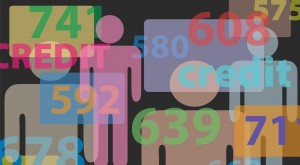¿Cuáles son los rangos de FICO Score®?
Cuando intenta mejorar su puntaje crediticio, es importante saber cómo clasifican los prestamistas los puntajes crediticios. De esa manera, puede determinar dónde debe estar el suyo para lograr sus objetivos financieros.

Es fantástico aumentar su puntaje en 100 puntos, pero si todavía se encuentra en la categoría "malo", no tendrá mucha suerte para que le aprueben un préstamo, una tarjeta de crédito o una hipoteca.
Rango de puntuación FICO®:300 – 850
Entonces, ¿cómo se clasifican los puntajes FICO? Las categorías pueden variar según el prestamista, pero los puntajes suelen ser los siguientes:
Excelente crédito:800 – 850
Es más probable que le aprueben un préstamo o una tarjeta de crédito, además de que recibirá acceso a las mejores tasas de interés y términos. El puntaje de crédito más alto que puede tener es 850.
Muy buen crédito:740 – 799
Aún obtendrá algunas de las mejores tasas cuando solicite un crédito. De hecho, algunos prestamistas consideran 720 como el umbral para las tasas de interés más bajas, por lo que es posible que ni siquiera importe si su puntaje es más alto que eso.
Buen crédito:670 – 739
El puntaje de crédito promedio de los estadounidenses es 695, que cae en la categoría de "bueno". Probablemente no tenga muchos elementos negativos importantes en su informe de crédito, pero hay margen de mejora para asegurarse de obtener las mejores condiciones de financiación.
Crédito justo:580 – 669
Sus tasas en esta categoría definitivamente no serán las mejores disponibles, lo que podría terminar costándole miles de dólares, si no más, la próxima vez que obtenga un préstamo o tenga un saldo en su tarjeta de crédito.
Mal crédito:300 – 579
Definitivamente tiene algunos elementos negativos y es posible que tenga problemas para que le aprueben un crédito, ya sea una nueva tarjeta o un préstamo. Si obtiene la aprobación, sus tarifas serán extremadamente altas.
La buena noticia es que hay mucho margen de mejora en la categoría. La mala noticia es que probablemente necesitará esa mejora para obtener la aprobación de un préstamo. Por ejemplo, el puntaje mínimo para un préstamo hipotecario de la FHA es 580, por lo que definitivamente no será elegible si su crédito está en esta categoría.
Gráfico de puntuación FICO®
Probablemente sepa dónde se encuentra usted en estas categorías de crédito, pero ¿qué hay de todos los demás en el país? Con un 54,7 %, poco más de la mitad de la población tiene una puntuación de 700 o superior.
Alrededor del 23 % de las personas tienen un puntaje entre 600 y 699, y el 22 % de las personas tienen un puntaje de menos de 600. Eso significa que casi una cuarta parte de los estadounidenses tienen mal crédito o están a punto de caer por debajo del umbral de 579.
| Muy pobre | Pobre | Promedio | Bien | Muy bueno | Excelente |
| 579 | 619 | 679 | 719 | 779 | 850 |
| 578 | 618 | 678 | 718 | 778 | 849 |
| 577 | 617 | 677 | 717 | 777 | 848 |
| 576 | 616 | 676 | 716 | 776 | 847 |
| 575 | 615 | 675 | 715 | 775 | 846 |
| 574 | 614 | 674 | 714 | 774 | 847 |
| 573 | 613 | 673 | 713 | 773 | 846 |
| 572 | 612 | 672 | 712 | 772 | 845 |
| 571 | 611 | 671 | 711 | 771 | 844 |
| 570 | 610 | 670 | 710 | 770 | 843 |
| 569 | 609 | 669 | 709 | 769 | 842 |
| 568 | 608 | 668 | 708 | 768 | 841 |
| 567 | 607 | 667 | 707 | 767 | 840 |
| 566 | 606 | 666 | 706 | 766 | 839 |
| 565 | 605 | 665 | 705 | 765 | 838 |
| 564 | 604 | 664 | 704 | 764 | 837 |
| 563 | 603 | 663 | 703 | 763 | 836 |
| 562 | 602 | 662 | 702 | 762 | 835 |
| 561 | 601 | 661 | 701 | 761 | 834 |
| 560 | 600 | 660 | 700 | 760 | 833 |
| 559 | 599 | 659 | 699 | 759 | 832 |
| 558 | 598 | 658 | 698 | 758 | 831 |
| 557 | 597 | 657 | 697 | 757 | 830 |
| 556 | 596 | 656 | 696 | 756 | 829 |
| 555 | 595 | 655 | 695 | 755 | 828 |
| 554 | 594 | 654 | 694 | 754 | 827 |
| 553 | 593 | 653 | 693 | 753 | 826 |
| 552 | 592 | 652 | 692 | 752 | 825 |
| 551 | 591 | 651 | 691 | 751 | 824 |
| 550 | 590 | 650 | 690 | 750 | 823 |
| 549 | 589 | 649 | 689 | 749 | 822 |
| 548 | 588 | 648 | 688 | 748 | 821 |
| 547 | 587 | 647 | 687 | 747 | 820 |
| 546 | 586 | 646 | 686 | 746 | 819 |
| 545 | 585 | 645 | 685 | 745 | 818 |
| 544 | 584 | 644 | 684 | 744 | 817 |
| 541 | 583 | 643 | 683 | 743 | 816 |
| 540 | 582 | 642 | 682 | 742 | 815 |
| 539 | 581 | 641 | 681 | 741 | 814 |
| 538 | 580 | 640 | 680 | 740 | 813 |
| 537 | 639 | 739 | 812 | ||
| 536 | 638 | 738 | 811 | ||
| 535 | 637 | 737 | 810 | ||
| 534 | 636 | 736 | 809 | ||
| 533 | 635 | 735 | 808 | ||
| 532 | 634 | 734 | 807 | ||
| 531 | 633 | 733 | 806 | ||
| 530 | 632 | 732 | 805 | ||
| 529 | 631 | 731 | 804 | ||
| 528 | 630 | 730 | 803 | ||
| 527 | 629 | 729 | 802 | ||
| 526 | 628 | 728 | 801 | ||
| 525 | 627 | 727 | 800 | ||
| 524 | 626 | 726 | 799 | ||
| 523 | 625 | 725 | 798 | ||
| 522 | 624 | 724 | 797 | ||
| 521 | 623 | 723 | 796 | ||
| 520 | 622 | 722 | 795 | ||
| 519 | 621 | 721 | 794 | ||
| 518 | 620 | 720 | 793 | ||
| 517 | 792 | ||||
| 516 | 791 | ||||
| 515 | 790 | ||||
| 514 | 789 | ||||
| 513 | 788 | ||||
| 512 | 787 | ||||
| 511 | 786 | ||||
| 510 | 785 | ||||
| 509 | 784 | ||||
| 508 | 783 | ||||
| 507 | 782 | ||||
| 506 | 781 | ||||
| 505 | 780 | ||||
| 504 | |||||
| 503 | |||||
| 502 | |||||
| 501 | |||||
| 500 | |||||
| 499 | |||||
| 498 | |||||
| 497 | |||||
| 496 | |||||
| 495 | |||||
| 494 | |||||
| 493 | |||||
| 492 | |||||
| 491 | |||||
| 490 | |||||
| 489 | |||||
| 488 | |||||
| 487 | |||||
| 486 | |||||
| 485 | |||||
| 484 | |||||
| 483 | |||||
| 482 | |||||
| 481 | |||||
| 480 | |||||
| 479 | |||||
| 478 | |||||
| 477 | |||||
| 476 | |||||
| 475 | |||||
| 474 | |||||
| 473 | |||||
| 472 | |||||
| 471 | |||||
| 470 | |||||
| 469 | |||||
| 468 | |||||
| 467 | |||||
| 466 | |||||
| 465 | |||||
| 464 | |||||
| 463 | |||||
| 462 | |||||
| 461 | |||||
| 460 | |||||
| 459 | |||||
| 458 | |||||
| 457 | |||||
| 456 | |||||
| 455 | |||||
| 454 | |||||
| 453 | |||||
| 452 | |||||
| 451 | |||||
| 450 | |||||
| 449 | |||||
| 448 | |||||
| 447 | |||||
| 446 | |||||
| 445 | |||||
| 444 | |||||
| 443 | |||||
| 442 | |||||
| 441 | |||||
| 440 | |||||
| 439 | |||||
| 438 | |||||
| 437 | |||||
| 436 | |||||
| 435 | |||||
| 434 | |||||
| 433 | |||||
| 432 | |||||
| 431 | |||||
| 430 | |||||
| 429 | |||||
| 428 | |||||
| 427 | |||||
| 426 | |||||
| 425 | |||||
| 424 | |||||
| 423 | |||||
| 422 | |||||
| 421 | |||||
| 420 | |||||
| 419 | |||||
| 418 | |||||
| 417 | |||||
| 416 | |||||
| 415 | |||||
| 414 | |||||
| 413 | |||||
| 412 | |||||
| 411 | |||||
| 410 | |||||
| 409 | |||||
| 408 | |||||
| 407 | |||||
| 406 | |||||
| 405 | |||||
| 404 | |||||
| 403 | |||||
| 402 | |||||
| 401 | |||||
| 400 | |||||
| 399 | |||||
| 398 | |||||
| 397 | |||||
| 396 | |||||
| 395 | |||||
| 394 | |||||
| 393 | |||||
| 392 | |||||
| 391 | |||||
| 390 | |||||
| 389 | |||||
| 388 | |||||
| 387 | |||||
| 386 | |||||
| 385 | |||||
| 384 | |||||
| 383 | |||||
| 382 | |||||
| 381 | |||||
| 380 | |||||
| 379 | |||||
| 378 | |||||
| 377 | |||||
| 376 | |||||
| 375 | |||||
| 374 | |||||
| 373 | |||||
| 372 | |||||
| 371 | |||||
| 370 | |||||
| 369 | |||||
| 368 | |||||
| 367 | |||||
| 366 | |||||
| 365 | |||||
| 364 | |||||
| 363 | |||||
| 362 | |||||
| 361 | |||||
| 360 | |||||
| 359 | |||||
| 358 | |||||
| 357 | |||||
| 356 | |||||
| 355 | |||||
| 354 | |||||
| 353 | |||||
| 352 | |||||
| 351 | |||||
| 350 | |||||
| 349 | |||||
| 348 | |||||
| 347 | |||||
| 346 | |||||
| 345 | |||||
| 344 | |||||
| 343 | |||||
| 342 | |||||
| 341 | |||||
| 340 | |||||
| 339 | |||||
| 338 | |||||
| 337 | |||||
| 336 | |||||
| 335 | |||||
| 334 | |||||
| 333 | |||||
| 332 | |||||
| 331 | |||||
| 330 | |||||
| 329 | |||||
| 328 | |||||
| 327 | |||||
| 326 | |||||
| 325 | |||||
| 324 | |||||
| 323 | |||||
| 322 | |||||
| 321 | |||||
| 320 | |||||
| 319 | |||||
| 318 | |||||
| 317 | |||||
| 316 | |||||
| 315 | |||||
| 314 | |||||
| 313 | |||||
| 312 | |||||
| 311 | |||||
| 310 | |||||
| 309 | |||||
| 308 | |||||
| 307 | |||||
| 306 | |||||
| 305 | |||||
| 304 | |||||
| 303 | |||||
| 302 | |||||
| 301 | |||||
| 300 |
Why Good Credit Matters
It’s important to have a good credit score as high as possible because the higher your interest rate, the more money you’ll pay over time. That can really add up for high-value loans like cars or mortgages.
Let’s look at a quick example. If you have excellent credit and take out a mortgage for $100,000 over 30 years and your rate is a low 3.92%, you’ll end up paying an additional $70,000 in interest payments.
If you think that’s a lot of money, wait until you see the next set of numbers. Bump that rate up to 5.92% for someone with a lower credit score, and they’ll end up paying over $113,000 in interest. That’s more than the loan itself! And it’s $43,000 more than the first person paid with a better interest rate.
The High Cost of Bad Credit
Even if you’re not planning on buying a home anytime soon, the same principles apply to credit cards, car loans, student loans, and other loans. The lower your credit score, the more money you’ll have to pay. Plus, landlords and even some employers now do credit checks as part of their application processes.
With a bad credit score, you might have difficulty finding a home or even a job. And if you have a financial emergency, you might be stuck with high-fee options like payday loans or title loans, which can add up fast and even cost you your car.
If you fall into one of the lower credit rankings, it’s time to start evaluating your credit reports. That way you can find out how you can improve that score and keep your financial opportunities wide open.
Industry Specific Credit Scores
Now that you know what a good credit score is, it’s time to get more specific.
Traditional FICO scores from the popular scoring company Fair Isaac Corporation range from 300 to 850. However, there are actually several credit scoring models that lenders might use when judging your creditworthiness. These vary depending on what type of credit you’re applying for.
A few examples include versions specifically for mortgages, car loans, credit cards, and student loans. Each one will look at slightly different information that is more relevant to the exact type of credit you want.
Your Credit Scores Are Different Depending on What You Apply For
The model for credit cards more heavily weighs your revolving payment history, while the auto-version is going to pay more attention to your past car payments.
There are a couple of tricky parts that come with these alternative scoring models. The first is that you probably won’t know which credit scoring model your lender is going to use unless you ask.
Additionally, the credit score ranges are different from the traditional FICO model. Instead of ranging between 300 and 850, the industry-specific scores range between 250 and 900.
On the auto credit range, for example, you’ll want at least a 750 to get the best interest rates. So, you can see how the numbers vary slightly for each different model.
FICO vs. VantageScore
While FICO scores are the most popular ones used by lenders today, there are other companies competing in this space. The other major model is called VantageScore, which was actually created by the three credit bureaus.
VantageScore 2.0, which is still used by some lenders, calculates credit anywhere between 501 and 990.
The latest version, VantageScore 3.0, uses the same range as FICO to reduce confusion, 300–850. Just like FICO, the higher score you have on both types of VantageScore models, the better a lender views your credit.
What Else Do Lenders Look at Besides Credit Score?
Clearly, your credit score is a massive component of any financial application process. If you don’t meet certain minimums, there’s no way you’ll get approved or access the very best rates. That being said, lenders look at a lot of additional information beyond your credit score and credit report.
They also analyze your income level to make sure you can afford the loan amount you’ve requested. Even if you earn six figures, if you have too much debt or the loan amount is too high, the lender might question your ability to make your payment each month.
Employment History
They also look at your employment history. No matter how great your credit is, or how much money you make, most lenders want to see that you’ve been in the same job (or at least the same industry) for the past two years. They even check your tax statements and pay stubs to confirm your earnings and often require proof of employment.
A lender might also want to know how much in cash reserves you have on hand. They’ll likely want to see bank statements because the more savings you have, the more cushion you have to repay the loan even if you have a financial emergency, like medical bills or a lost job.
How to Get the Best Credit Score
Start by consistently paying all of your bills on time and in full. This is the best thing you can do for your credit score because it accounts for 35%—the biggest factor considered!
You should also order a free copy of your credit report to get an idea of what exactly is bogging down your score. Is there anything on there that’s incorrect or out of date? You might be able to dispute it and have it removed.
In the event you have multiple negative items, you could greatly benefit from talking to a credit repair company to help you clean up your credit history.
Get a Free Credit Consultation
Most companies, like Lexington Law Firm, offer a free consultation so you can ask questions about your specific situation and find out exactly what they can help you with.
Knowledge is power, and finding out your credit score and learning what range you fall in can help you plan the next steps in your financial future.
Never assume the worst-case scenario; there’s no such thing as a lost cause. Everyone, no matter how bad their credit score is, has the potential to improve their financial situation.
It might take a little time and effort, but it’s always doable. Professional credit repair companies that have been in the business for a long time have truly seen it all. Don’t be afraid to give one a call today and find out what you can do to increase your credit score.
¿Listo para aumentar su puntaje de crédito?
¡Llame para una consulta de crédito gratis!
bancario
- ¿Qué es R1 e I1 en el informe de crédito?
- ¿Cuáles son las dimensiones de una tarjeta de crédito?
- ¿Cuáles son los elementos del crédito?
- ¿Cuáles son los beneficios de pedir dinero prestado?
- ¿Cuáles son las similitudes entre los bancos y las cooperativas de crédito?
- ¿Cuál es el puntaje crediticio mínimo para comprar una casa?
- ¿Qué es un puntaje de crédito?
- ¿Cuáles son los diferentes tipos de deuda?
- ¿Cuál es el puntaje de crédito más alto?
-
 ¿Cuál es el puntaje de crédito más alto que puede obtener?
¿Cuál es el puntaje de crédito más alto que puede obtener? El rango de crédito estándar para los modelos de puntuación de crédito más populares, FICO y VantageScore, es 300-850. Este rango ha llevado a muchas personas a creer que necesitan un crédito perfecto...
-
 ¿Qué es un puntaje FICO?
¿Qué es un puntaje FICO? Si alguna vez intentó obtener un préstamo o solicitó una tarjeta de crédito, es probable que haya escuchado el término puntuación FICO mencionado en más de una ocasión. Sin embargo, si solo está est...


